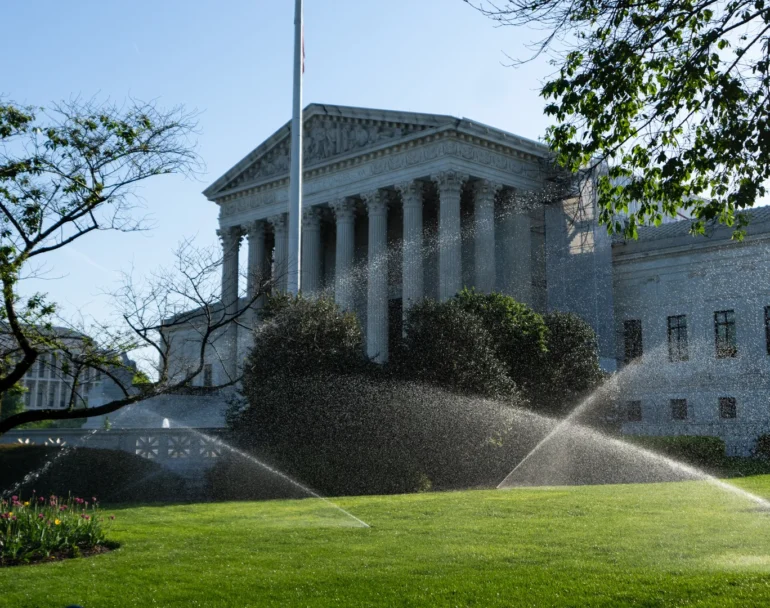
Supreme Court guts agency power in seismic Chevron ruling
The Supreme Court on Friday curtailed the executive branch’s ability to interpret laws it’s charged with implementing, giving the judiciary more say in what federal agencies can do.
Why it matters: The landmark 6-3 ruling along ideological lines overturns the court’s 40-year-old “Chevron deference” doctrine. It could make it harder for executive agencies to tackle a wide array of policy areas, including environmental and health regulations and labor and employment laws.
Driving the news: Chief Justice John Roberts, writing the opinion of the court, argued Chevron “defies the command of” the Administrative Procedure Act, which governs federal administrative agencies.
- He said it “requires a court to ignore, not follow, ‘the reading the court would have reached had it exercised its independent judgment as required by the APA.'”
- Further, he said it “is misguided” because “agencies have no special competence in resolving statutory ambiguities. Courts do.”
Roberts noted the court’s decision did not call into question prior cases that relied on Chevron, including holdings pertaining to the Clean Air Act, because they “are still subject to statutory stare decisis despite our change in interpretive methodology.”
- “Mere reliance on Chevron cannot constitute a ‘special justification’ for overruling such a holding,” he said.
Justice Elena Kagan, in a dissenting opinion, wrote that the ruling Friday was “yet another example of the Court’s resolve to roll back agency authority, despite congressional direction to the contrary.”
- “Congress knows that it does not — in fact cannot — write perfectly complete regulatory statutes,” she wrote. “It knows that those statutes will inevitably contain ambiguities that some other actor will have to resolve, and gaps that some other actor will have to fill. And it would usually prefer that actor to be the responsible agency, not a court.“
- She warned the decision “is likely to produce large-scale disruption.”
- “In one fell swoop, the majority today gives itself exclusive power over every open issue — no matter how expertise-driven or policy-laden — involving the meaning of regulatory law.”
- “The majority disdains restraint, and grasps for power.”
Context: The ruling marks another major victory for conservatives, who for decades have sought to limit the federal government’s ability to regulate businesses.
- In the wake of the court’s ruling, it’s expected that more federal rules will be challenged in the courts and judges will have greater discretion to invalidate agency actions.
- The decision comes one day after the Supreme Court curtailed federal agencies’ use of administrative law judges in another blow to the administrative state.
How it works: The doctrine was created by the Reagan-era Supreme Court in Chevron U.S.A. v. Natural Resources Defense Council in 1984 and has since become the most cited Supreme Court decision in administrative law.
- Under Chevron deference, courts would defer to how to expert federal agencies interpret the laws they are charged with implementing provided their reading is reasonable — even if it’s not the only way the law can be interpreted.
- It allowed Congress to rely on the expertise within the federal government when implementing everything from health and safety regulations to environmental and financial laws.
Zoom in: However, Chevron was challenged in two separate cases over a National Marine Fisheries Service regulation meant to prevent overfishing on commercial fishing vessels.
- Fishing companies challenging the regulation claimed the doctrine violated Article III of the Constitution by shifting the authority to interpret federal law from the courts to the executive branch.
- They also claimed it violated Article I by allowing agencies to formulate policy when only Congress should have lawmaking power.
The other side: The government argued that the doctrine had safeguards within it that prevented agencies from usurping Congress’s lawmaking authority.
- It noted that Chevron only applied to ambiguous text in laws passed by Congress and instances in which lawmakers had given interpretive authority to an agency.
- The doctrine was also necessary to limit federal judges’ abilities to make public policy when they may not have the expertise to do so and aren’t subject to democratic accountability, the government said.
Between the lines: Lawyers who worked pro bono to represent fishing companies involved in the cases are also staff attorneys for Americans for Prosperity, a libertarian political advocacy group funded by billionaire Charles Koch, the New York Times reported earlier this year.
- The political network associated with Charles Koch and his late brother, David Koch, have long championed efforts to get cases before the Supreme Court that, if decided in their favor, would roll back the federal government’s regulatory powers.
- The Koch network also successfully attracted Supreme Court Justice Clarence Thomas, who voted against the doctrine, to speak at at least one of its donor events in 2018, ProPublica reported last year.
- It’s unclear who purchased Thomas’ flight to the 2018 event, as he never reported it in his annual financial disclosure form. Thomas has attended at least two of such events in past years.
The big picture: In recent years, Chevron had fallen out of favor of the conservative-majority Supreme Court, which had declined to apply it or cite it in cases which it may once have applied.
- The ruling comes as some federal judges have taken a more active role in overruling agency expertise.
- For example, Texas District Judge Matthew Kacsmaryk last April paused the FDA’s original 23-year-old approval of the abortion pill mifepristone in a case that’s now to be decided by the Supreme Court.